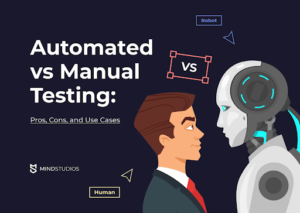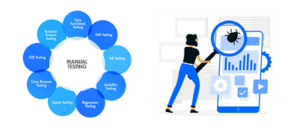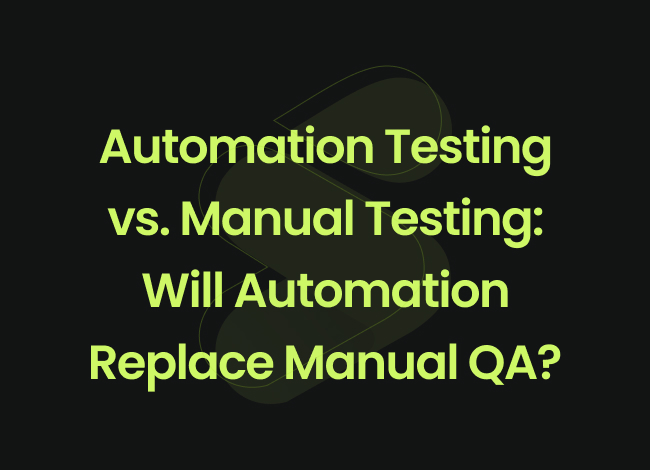Introduction:
First of all, it is relevant to note that software testing is one of the rapidly developing spheres of the tech industry. Currently, the global software testing market size is estimated to be $45 billion and is projected to underpin a CAGR of 6% within the 2023 to 2030 period. Testing is considered a vital part of software development as it helps evaluate the quality and reliability of the developed applications and many more in this sphere. This is due to the fact that as technology evolves, the rivalry that exists between automation vs manual testing increases.
Software testing is usually divided into two main types: automation testing vs. manual testing. But what’s the main difference between them? In this article we are going to answer all the questions related to this topic.
Automated vs Manual Testing

Manual Testing:
We will thoroughly explore manual testing and highlight its key features first.
Manual testing is a type of software testing where tests are executed by a QA engineer manually, without the use of any automation tools. Manual testing involves human testers who execute test cases without automation tools. This approach involves evaluating the software from a human perspective. Manual testing has been an essential part of the quality assurance process since the inception of software development. It is suitable for a wide range of tasks and can be performed without extensive preparation. Without manual testing, popular software products would not perform as well, have as appealing a user interface, or be as resilient to potential attacks.

Key Uses of Manual Testing
The process of manual testing is one of the most common types of quality assessment that a company turns to for guaranteeing or improving the quality of an application. Will manual testing be replaced by automation? Not entirely. While automation is important, manual testing will still be needed for tasks that require human judgment. Let’s discover the key uses of manual testing together which make the future of manual testing bright.
Early Development Phase:
In the early stages, the application has a continuously changing design. Manual testing is better placed to handle these changes for the reason that it is more elastic while automation testing is cumbersome and may not be practical at the moment.
Short-Term or Small Projects:
That is why for such projects where the scope is relatively small or the jobs are of short-term, manual testing is more effective. Aromatic BCAA application of automation testing requires a large amount of time, money, and tools to be invested and hence, this testing is not suitable for small scale projects. This type of testing may be put into practice quickly; thus, it is usually favored. This shows the manual testing importance in this digital age.
Usability Testing:
It was established that some of the automation tools can display testing scenarios like a common end-user, and yet, they cannot mimic a human tester in their extraordinary behaviors. The major strength of manual testing is in the area of usability and user experience of a product.
User Acceptance:
All sorts of testing stand to gain significantly when they include hints of human instinct and interface. While In manual vs automation testing, the manual testing is still more effective when done manually; such as the user acceptance testing, ad-hoc testing, and exploratory testing.
Testing Physical Products:
Thus, in the case of located systems like IoT products, automotive systems, or medical devices, manual testing turns out to be more effective. Sometimes, automation can be problematic in these cases, and mere manual testing is more preferable and elastic to satisfy the peculiarities of physical objects.
Time to Step Out of the Manual Testing Box
Manual testing has its limitations, and there are scenarios where it might not be the best choice:
Limited Human Resources:
To declare that manual QA should focus on repetitive tasks, when your team is already thin-centered, is to leave them with the potential of not addressing other sections in the application as well.
Risk of Human Error:
Manual testing at any level of skill always encompasses the risks that are characteristic of human error. Where precision of results is paramount, then the cost of these mistakes may not be manageable.
Long-Term Projects:
For projects with long-term durations that involve extensive repetitive testing, automation is typically more efficient. Automated tests can handle large volumes of repeated tests more effectively than manual testing, which can become impractical over time.
Automation Testing:
Automated testing is one of the most common styles of software testing where test cases are run with the help of tools and frameworks. While, in manual testing, all the tests are performed and controlled by human beings, in automation testing, tests are scripted once and run repeatedly with less human control. Automation testing advantages include faster execution, increased test coverage, and the ability to run repetitive tests efficiently. Its usefulness lies in the fact that this approach is especially helpful when it is necessary to repeatedly run the same tests and, therefore, is a perfect instrument for raising efficiency and reliability.

Here are some pros and cons of Automation Testing:
Uses of Automation Testing:
Although manual testing is effective, there are numerous strengths that come with automation testing in a number of conditions. To learn automation vs manual testing stay with us.
Running Repeated Tests:
What suits automation best is the test cases that are to be run frequently, for example in regression testing. If the same test suite is done daily or multiple times then it would be easier to automate and you would not have to spend a lot of time doing it and there is a high possibility that mistakes could be made. This is the one of the most important benefits of automation testing over manual testing.
Performance and Load Testing:
These types of testing are very time consuming and may take a lot of resources in order to find more on performance and security. Performance and load testing can be managed effectively by automation testing advantages, giving an overall of the product’s capacity from different angles.
Large Number of Test Cases:
The level of difficulty increases, and manual testing takes much time when the number of test cases to be run is very large. Automation testing is also beneficial when it comes to handling big test suites where Automation testing not only speeds up the testing process but also covers more ground than manual testing while at the same time ensuring the quality of the tests.
Eliminating Human Error:
Even though human insight is good, it is desirable to minimize the occurrence of such errors in some situations. Such risks can, however, be eliminated through automation testing since it produces more accurate tests than manual testing.
Handling Large Volumes of Data:
Automation testing is quite appropriate in handling large volumes of data since it is speedy in its performance. For instance, database testing can be automated as it can sort through millions of entries which would otherwise take the complement of manual testing to do, as it deals with huge data.
Drawbacks of Automation Testing
High Initial Costs: Requires significant investment in tools, infrastructure, and training.
Complex Setup and Maintenance: Needs regular updates and specialized skills for script maintenance.
limited Exploratory Testing: Not suited for creative, unstructured testing by humans.
Handling UI Changes: Sensitive to UI modifications, causing frequent script failures.
Simulating Human Behavior: Can’t fully replicate nuanced human interactions.
Requires Skilled Personnel: Demands expertise in scripting and testing frameworks.
Not Ideal for Short-Term Projects: Setup time and resources may not be justified for small projects.
Limited Flexibility: Automated tests follow scripts and may not adapt well to changes.
In summary, automation testing enhances efficiency and accuracy but is best used alongside manual testing to balance their strengths and weaknesses. But when choosing between manual testing vs. automated testing, it’s important to consider the type of tasks and the efficiency needed.
Will Automation Replace Manual Testing?

This Manual vs automation testing highlights the strengths of each approach.
Automation testing often delivers significant benefits of automation testing over manual testing, especially in repetitive and large-scale scenarios. However, there remains a critical need for skilled manual testers for tasks requiring human insight and adaptability, highlighting the manual testing importance. So, to say,” is manual testing dead?” is not true. The decision between manual testing vs. automated testing depends on the specific needs of the project, including the type of testing required and the resources available.
As we look to the future of manual testing, it’s important to consider whether manual testing will be replaced by automation testing. While automation provides many advantages, such as increased efficiency and consistency, the pros and cons of automation testing indicate that manual methods still excel in areas requiring flexibility and human judgment. The manual testing future will continue to be important, especially for tasks that require human insight and adaptability, even as automation technologies advance.
Ultimately, there is no universal answer to the manual testing vs automation testing debate. The best approach involves understanding the manual testing future and integrating both methodologies to achieve the desired outcomes effectively.
Conclusion:
In conclusion, the debate over automation testing vs manual testing shows that both methods have their strengths. So, thinking about will automation replace manual testing is just a waste of time.Automation testing excels in efficiency and consistency but will not completely replace manual testing. Each approach manual testing vs automation testing has unique benefits and is suited to different scenarios. This balanced approach ensures comprehensive testing and is well-supported on platforms like Siznam. Understanding when to use each method is key to effective quality assurance. By combining automation testing vs manual testing, teams can leverage the advantages of both to achieve the best results. At Siznam, you can enjoy both types of testing.






